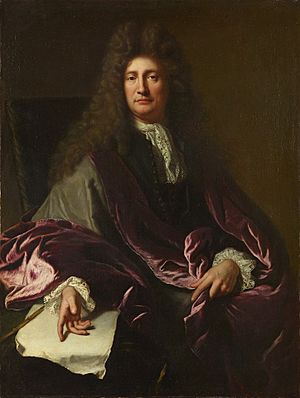Charles de La Fosse facts for kids
Quick facts for kids
Charles de La Fosse
|
|
|---|---|

La Fosse at the age of 52, by André Bouys (1688)
|
|
| Born | 15 June 1636 Paris, France
|
| Died | 13 December 1716 (aged 80) Paris, France
|
| Nationality | French |
| Known for | Painting |
Charles de La Fosse (born June 15, 1636 – died December 13, 1716) was an important French painter. He was born in Paris, France. His art helped change the style of painting in France during his time.
Life of a French Painter
Charles de La Fosse was a student of Charles Le Brun, a very famous artist. La Fosse helped Le Brun with many large art projects for King Louis XIV. These projects were grand decorations for royal buildings.
In 1662, La Fosse left France to travel. He spent two years in Rome, Italy, and three years in Venice, Italy. These trips helped him learn new painting styles and techniques.
When he returned to France, he quickly became a professor of art. In 1689, a rich English nobleman, Lord Montagu, invited him to London. La Fosse decorated Montagu House in Bloomsbury.
Working in England and France
La Fosse visited London twice. On his second visit, he stayed for more than two years. King William III of England wanted him to decorate Hampton Court Palace. However, La Fosse decided to return to Paris.
He was needed back in France to work on a very important building. He was asked to paint the large dome of Les Invalides in Paris. This dome is one of his most famous works that you can still see today.
Sadly, the decorations he made for Montagu House in London were later destroyed. His works at the Palace of Versailles have been restored over time. However, his painting The Finding of Moses from Versailles is now in the Louvre Museum.
In his later years, La Fosse created many other important artworks. He painted in public buildings and private homes. He died in Paris on December 13, 1716.
Changing Art Styles
Charles de La Fosse's art was very important in French history. He helped move art away from the strict, formal style of King Louis XIV's court. This older style was called Classicism. La Fosse's work helped introduce a lighter, more playful style known as the Rococo period.
Not much is known about his early paintings before 1680. But his later works show how he helped bring about this new, exciting art movement.
See also
 In Spanish: Charles de La Fosse para niños
In Spanish: Charles de La Fosse para niños

